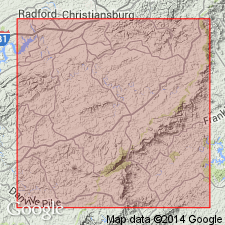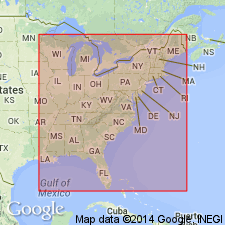
- Usage in publication:
-
- Little River gneiss
- Modifications:
-
- Named
- Dominant lithology:
-
- Gneiss
- AAPG geologic province:
-
- Piedmont-Blue Ridge province
Summary:
Little River gneiss in southwestern VA is here described as a highly sheared blue quartz augen gneiss plus or minus feldspar augen. Unit appears to be mixed with rocks of Blue Ridge complex and to grade upward into rocks mapped as Lynchburg formation (which may not be correlative with type Lynchburg). Contact with complex poorly defined. Contact with Lynchburg described as intercalated layers or rock essentially identical with those of either side of zone plus a few layers of rock intermediate in composition. May be same age as Willis phyllite (new). Locally grades into Alum phyllite (new). Absolute, relative, and geologic age data suggest that Little River gneiss and rocks mapped as belonging to Lynchburg formation once belonged to same sedimentary sequence and are older than late Precambrian.
Source: GNU records (USGS DDS-6; Reston GNULEX).

- Usage in publication:
-
- Little River Gneiss
- Modifications:
-
- Not used
- AAPG geologic province:
-
- Piedmont-Blue Ridge province
Summary:
Little River Gneiss of Dietrich (1959) is included, in part, within the Elk Park Plutonic Group as it is mapped in Grayson Co. on the VA State map. Unit is not separately mapped.
Source: GNU records (USGS DDS-6; Reston GNULEX).

- Usage in publication:
-
- Little River Gneiss*
- Modifications:
-
- Geochronologic dating
- AAPG geologic province:
-
- Piedmont-Blue Ridge province
Summary:
Little River Gneiss has U-Pb zircon upper intercept ages of 1130 Ma (Sinha and Bartholomew, 1984) and 1117 Ma (T.W. Stern and D.W. Rankin, unpub. data), and 207Pb/206Pb age of 1116 Ma (T.W. Stern and D.W. Rankin, unpub. data).
Source: GNU records (USGS DDS-6; Reston GNULEX).

- Usage in publication:
-
- Little River Gneiss
- Modifications:
-
- Overview
- AAPG geologic province:
-
- Piedmont-Blue Ridge province
Summary:
Horsepen Mountain Suite in the Roanoke area is separated by a few miles from the Little River Gneiss, which is an augen-bearing biotite gneiss. Granite is found throughout the intervening area. It seems likely, according to authors, that the granite and the Little River Gneiss are part of the Horsepen Mountain Suite as the Suite is predominantly coarse-grained ferrodiorite associated with coarse-grained jotunite, granite, abundant biotite augen gneiss, and fine-to medium-grained, porphyritic dikes.
Source: GNU records (USGS DDS-6; Reston GNULEX).
For more information, please contact Nancy Stamm, Geologic Names Committee Secretary.
Asterisk (*) indicates published by U.S. Geological Survey authors.
"No current usage" (†) implies that a name has been abandoned or has fallen into disuse. Former usage and, if known, replacement name given in parentheses ( ).
Slash (/) indicates name conflicts with nomenclatural guidelines (CSN, 1933; ACSN, 1961, 1970; NACSN, 1983, 2005, 2021). May be explained within brackets ([ ]).

